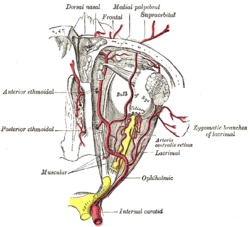Medial palpebral arteries
| Medial palpebral arteries | |
|---|---|
 The ophthalmic artery and its branches. (Medial palpebral labeled at center top.) | |
| Details | |
| Source | ophthalmic artery |
| Branches | superior palpebral arch inferior palpebral arch |
| Supplies | eyelids |
| Identifiers | |
| Latin | arteriae palpebrales mediales |
| TA98 | A12.2.06.044 |
| TA2 | 4496 |
| FMA | 70785 |
| Anatomical terminology | |
The medial palpebral arteries (internal palpebral arteries) are arteries of the head. They are two in number, superior and inferior, that arise from the ophthalmic artery near its terminal branches. The arteries branch from the ophthalmic artery in the superomedial orbit near the trochlea of the superior oblique muscle.
Course[]
They leave the orbit to encircle the eyelids near their free margins, forming a superior and an inferior arch, which lie between the orbicularis oculi and the tarsi.
The superior palpebral arch anastomoses, at the lateral angle of the orbit, with the zygomaticoörbital branch of the temporal artery and with the upper of the two lateral palpebral branches from the lacrimal artery.
The inferior palpebral arch anastomoses, at the lateral angle of the orbit, with the lower of the two lateral palpebral branches from the lacrimal and with the transverse facial artery, and, at the medial part of the lid, with a branch from the angular artery.
From this last anastomoses a branch passes to the nasolacrimal duct, ramifying in its mucous membrane, as far as the inferior meatus of the nasal cavity.
Additional images[]

Bloodvessels of the eyelids, front view.
References[]
![]() This article incorporates text in the public domain from page 570 of the 20th edition of Gray's Anatomy (1918)
This article incorporates text in the public domain from page 570 of the 20th edition of Gray's Anatomy (1918)
- Wikipedia articles incorporating text from the 20th edition of Gray's Anatomy (1918)
- Arteries of the head and neck
